
Communications in Physics, Vol. 17, No. 4 (2007), pp. 227-233
COMPETITION BETWEEN STOKES AND ANTI-STOKES WAVES
IN RAMAN FIBER LASER
CHU VAN LANH AND DINH XUAN KHOA
Faculty of Physics, Vinh University
Abstract. The set of intracavity field equations describing the evolution of intra-cavity pumping,
Stokes and anti-Stokes powers of Raman laser is presented. Most attention is given to intra-cavity
competition of two Raman waves, which depends on cavity properties, frequency shift and phase
mismatch. The calculated results are based on Ge-doped and D2-gas-in glass fiber lasers at
CW-regime and pulse-pumped regime.
I. INTRODUCTION
One of the bright achievements of laser physics in the 1990s was the creation of
highly efficient medium-power continuous-wave (CW) single-mode Raman fiber lasers for
the near infrared. The lasers differed mainly by the type of fibers which has various
Stokes (consequently anti-Stokes) frequency shifts, by the design of Stokes (anti-Stokes)
cavities, and by the pumping sources [1]. It is based on stimulated Raman scattering of
Raman material placed inside of optical resonator. The classical theory of Raman lasers is
improved to describe the operation of them [2, 3]. In previous works, when investigate the
unstationary regime of Raman laser operating at Stokes wave, it is clear that the power
of Stokes wave can be transfered to anti-Stokes wave, in many ways the opposite process
can be occur [4].
In this paper we present the competition between Stokes and anti-Stokes waves
depending on the phase mismatch, frequency shift and properties of optical resonator.
II. THE RATIO OF STOKES AND ANTI-STOKES POWERS FOR
CW-RAMAN LASER
We consider three intracavity fields: pump (mode-p), Stokes (mode-s) and anti-
Stokes (mode-a) as shown in Fig. 1.
In this situation, beside the two-photon Raman interaction, there also exists a four-
wave mixing process, by which the Stokes and anti-Stokes fields can be strongly coupled.
We assume a triple-resonance condition, i.e., all the three fields are resonant with the
cavity, although in reality this condition will be experimentally difficult due to dispersion
effects [3]. As shown in previous works [3, 4], the set of rate equations for intracavity

228 CHU VAN LANH AND DINH XUAN KHOA
J
a
b
Pump(p)
Pump(p)
Stokes(s) Anti-Stokes(a)
Frequencyshift Dw
Fig. 1. Energy level diagram of the far-off resonance Raman process
powers is
˙
Pp+γpPp=γeppPpPep −ωp
ωs
kp
ks
G(δ)8µ0
πb ωsPs−kp+ks
kp+ka
ωaPa
˙
Ps+γsPs=8µ0ωp
πbωs
G(δ)Pp[ωsPs−CωaPa]
˙
Pa+γaPa=−ωp
ωs
8µ0
πb G(δ)Ppkp+ks
kp+ka
ωaPa−CωsPs
(1)
where γq=(c/nqL)lnpR1qR2qis the intra-cavity lifetime of photon q-mode, γep =
(2c/npL)pT1pis the intracavity lifetime of external field, nqis the refractive index of fields
q, R is the cavity mirror’s reflectance, Tis the transmittance, the subscript “1” presents
the front mirror that couples the external field Eep, and “2” means back mirror, G(δ)≈
(−ωs/4) N~d2
0D/ε0γab/γ2
ab +δ2(λp/(λp+λs)) is the gain factor,Nis the number
density, Dis the population difference between levels aand b,γab is the coherence dephas-
ing rate, δis the two-photon detuning for a↔btransition, d0is the coupling constant
relating to third-order susceptibility χ(3),C=[(kp+ks)/Pk] sin (∆kL/2) /(∆kL/2) is
the coupling coefficient relating to phase mismatch, Pk=2kp+ks+ka,∆k=2kp−ks−ka
is the phase mismatch, Lis the cavity length, ∆φ=2φp−φs−φais the phase difference
between the three waves (relating to imaginary part of the field), and
Pq(t)=π$2
0qnq
4rε0
µ0|Eq(t)|2=πbq
4ωqµ0|Eq(t)|2,(2)
with considering bp≈bs≈ba=b.

COMPETITION BETWEEN STOKES AND ANTI-STOKES WAVES ... 229
The field amplitude equations at steady state (means for CW-Raman laser) have
the form
γpPp=γeppPpPep −ωp
ωs
kp
ks
G(δ)8µ0
πb ωsPs−kp+ks
kp+ka
ωaPa
γsPs=8µ0ωp
πbωs
G(δ)Pp[ωsPs−CωaPa]
γaPa=−ωp
ωs
8µ0
πb G(δ)Ppkp+ks
kp+ka
ωaPa−CωsPs
(3)
Let ξdenote the ratioPa/Ps, from two last Eqs.(3) we can eliminate Ppto obtain
Cωaγaξ2−γaωs+kp+ks
kp+ka
γsωaξ+Cγsωs=0,(4)
which has two roots
ξ±=
kp+ks
kp+ka
ωa
γs
γa
+ωs
2Cωa±skp+ks
kp+ka
ωa
γs
γa
+ωs2
−4C2ωsωa
γs
γa
2Cωa
(5)
We discard the root ξ+since it corresponds to Pa/Ps>1 which is physically im-
possible. We find that ξ−is a constant that is not dependent on the pumping rate and
that describes the competition between Stokes and anti-Stokes waves.
From (5), we can see that the competition between two waves depends not only
on the cavity properties (γs,γ
a), phase mismatch (C), their wavelengths (λq) (or exactly
frequency shift ∆ωshown in Fig.1), but on the confocal parameters (b).
III. COMPETITION IN TWO KINDS OF CW-RAMAN FIBER LASERS
In this calculation, we want to discuss a competition between anti-Stokes and Stokes
waves by finding dependence of their power ratio on laser cavity’s properties, phase mis-
match for four-wave-mixing, and two fibers with different frequency shifts. To simply, we
plot the dependence of ξ−on ratio γs/γachanging from 0% to 400% and phase mismatch
∆kL/2 changing from 0 to 2π. The wavelengths are chosen to be 1.06 µmof Diode-pumped
Nd-doped fiber for pump wave, 1.3 µmfor Stokes wave and 0.82 µmfor anti-Stokes wave
of Ge-doped fiber [5,6], and 1.55 µmfor Stokes wave and 0.58 µmfor anti-Stokes wave of
D2-gas-in-glass fiber [7].
The dependence of ratio ξ−on γs/γafor two above mentioned fiber lasers are illus-
trated in Fig. 2 and Fig. 3. From two figures one can see that the ratio ξ−increases when
the ratio γs/γaincreases. That means when reflectivity of mirrors for Stokes wave increases
the intracavity power of Stokes wave increases. Since the strongly coupling between Stokes
and anti-Stokes waves in four-waves-mixing, the intracavity power of anti-Stokes conse-
quently increases too. But, the saturation will be happen for anti-Stokes power, although
reflectivity for Stokes wave increases some time more than one for anti-Stokes.
Moreover, one can see too the intracavity power of anti-Stokes of D2-gas-in glass
laser (ξ−≥60% at γs/γa>400%) is more than one of Ge-doped laser (ξ−≤60% at
γs/γa>400% ). This behavior can be explained by transition probability between two
Raman levels, as illustrated in Fig. 1. When frequency shift ∆ωis larger the transition

230 CHU VAN LANH AND DINH XUAN KHOA
ReflectiveRatioofStockesandanti-StokesWaves
Fig. 2. ξ−vs γs/γafor wavelengths 1.06 µm, 1.3 µm and 0.82 µm of Raman
Ge-doped fiber laser
ReflectiveRatioofStockesandanti-StokesWaves
Fig. 3. ξvs γs/γafor wavelengths 1.06µm, 1.55 µm and 0.58 µmofD2-gas-in-
glass Raman laser
probability is smaller, so the energy transfer from pump and Stokes fields to anti-Stokes
field is more difficult, i.e., the coupling constant is limited. It is clear that the frequency
shift in Raman fiber influences on the competition between Stokes and anti-Stokes waves.
The dependence of ξ−on the phase mismatch is calculated and presented in Fig. 4
and Fig. 5 for two lasers. From two figures it is clear that the ratio ξ−reaches a maximum
at phase matching condition (∆k= 0) and decreases with increasing of phase mismatch
(∆kL). The shape of this characteristic is absolutely similar to one of phase-efficiency
characteristic of Second Harmonic Generation and Sum Frequency Generation in three-
wave-mixing [9].

COMPETITION BETWEEN STOKES AND ANTI-STOKES WAVES ... 231
Fig. 4. ξ−vs ∆kL/2 for wavelengths 1.06 µm, 1.3 µm and 0.82 µm of Ge-doped laser
Fig. 5. ξ−vs ∆kL/2 for wavelengths 1.06 µm, 1.55 µm and 0.58 µmofD2–
gas-in-glass laser
IV. COMPETITION IN PULSE-PUMPED D2-GAS-IN -GLASS LASER
Consider an external pump pulse is Gaussian given by
Pep (t)=Pmax exp
− √ln 2t
τ!2
,(6)
where Pmax is the peak, τis the half of duration, and a sample of Raman fiber laser consists
of the pump pulse, resonant cavity and Raman medium, which are chosen with parameters
given following. The pump pulse at wavelength 1.06µm (of Diode-pumped Neodym laser
for example) has an energy W=0÷4.510−5Jand half duration time τ=10ps,
which is focused in center of laser cavity with beam waist to be w=(0.05 ÷0.45) µm.

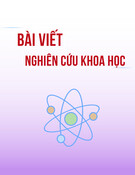

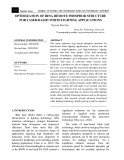
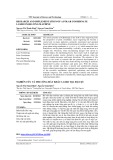
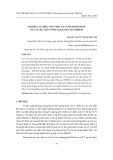
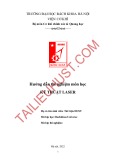
![Giáo trình Công nghệ laser Phần 1: [Thêm thông tin chi tiết để tối ưu SEO]](https://cdn.tailieu.vn/images/document/thumbnail/2015/20151207/gaugau1905/135x160/66221901.jpg)
![Tài liệu Laser: Tổng hợp [mô tả chi tiết hơn về loại tài liệu hoặc ứng dụng]](https://cdn.tailieu.vn/images/document/thumbnail/2015/20150311/dmanh87/135x160/1746414_346.jpg)
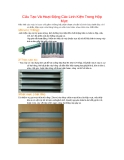

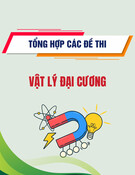







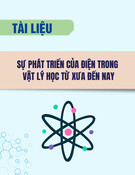
![Bộ câu hỏi lý thuyết Vật lý đại cương 2 [chuẩn nhất/mới nhất]](https://cdn.tailieu.vn/images/document/thumbnail/2025/20251003/kimphuong1001/135x160/74511759476041.jpg)
![Bài giảng Vật lý đại cương Chương 4 Học viện Kỹ thuật mật mã [Chuẩn SEO]](https://cdn.tailieu.vn/images/document/thumbnail/2025/20250925/kimphuong1001/135x160/46461758790667.jpg)




